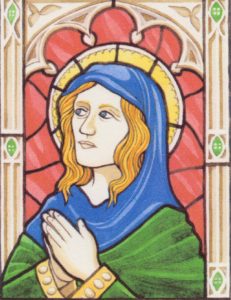 Saint Kyneburgh was a local Anglo-Saxon saint in Gloucester. Two of the characters in Memento Mori, a novel in my Lady Apollonia West Country Mysteries, have a relationship to this Anglo-Saxon saint. At the time of my novel in 1392, the bones of Saint Kyneburgh were buried in the chapel bearing her name that stood near the South Gate of the city. One of the characters in the story is Father Arnold, the priest of the Chapel of Saint Kyneburgh. The other is a hermit or anchorite whose cell was located between the city wall and the chapel. He devoted his life to the worship of the saint and especially to the protection of Saint Kyneburgh’s Well just a few steps outside the former place of the chapel and medieval wall.
Saint Kyneburgh was a local Anglo-Saxon saint in Gloucester. Two of the characters in Memento Mori, a novel in my Lady Apollonia West Country Mysteries, have a relationship to this Anglo-Saxon saint. At the time of my novel in 1392, the bones of Saint Kyneburgh were buried in the chapel bearing her name that stood near the South Gate of the city. One of the characters in the story is Father Arnold, the priest of the Chapel of Saint Kyneburgh. The other is a hermit or anchorite whose cell was located between the city wall and the chapel. He devoted his life to the worship of the saint and especially to the protection of Saint Kyneburgh’s Well just a few steps outside the former place of the chapel and medieval wall.
There is no remnant today of the chapel. Instead, there are modern sculptures which mark its location and that of the well. One, near the well, is a steel tower named Kyneburgh which is 16 metres high. It was designed by an artist, Tom Price, who also designed a 30-metre wall sculpture along the line of the medieval wall where the chapel once stood. The city commissioned these art works in 2011 to commemorate the site and were the first things we saw on our research trip to Gloucester in 2012 as we approached this part of Gloucester from the south.
Who was Saint Kyneburgh, pictured in a stained-glass window in the drawing, shown above, by our friend, Philip Moss? She may have been the sister of Osric, the man I wrote about on March 6, who founded the Abbey of Saint Peter as a community of monks and nuns who worshipped together under the rule of the first abbess, Kyneburgh. Not much is known of her, but one later story about her sainthood seems to differ from her being that abbess. It says that she refused her parents desires for her arraigned marriage, ran away, and went to work for a baker in Gloucester. He so admired her saintly character that he adopted her as his daughter, but his wife became jealous, killed Kyneburgh, and threw her body into a well just outside the South Gate of the city.
Miracles are said to have begun happening at this well leading to the formation of the cult of Kyneburgh. A chapel was built by the remains of the Roman south gate, and we know it was remodelled in 1147. By the time of my novel, the city had rebuilt the medieval south gate a little further to the east. The chapel by then had become the site where Kyneburgh’s bones are alleged to have been buried. In 1389, miracles mysteriously stopped when the bones were transported to nearby Llanthony Priory. The next year they were returned to the chapel, and the hermit’s cell was constructed and occupied. My story takes place two years later.
Today, there is a 13th century effigy of a woman in a chapel, the only remaining building of the medieval Saint Mary Magdalene Leper Hospital which was just outside Gloucester. The effigy was saved when the Chapel of Saint Kyneburgh was demolished, and tradition says it contains the remains of Saint Kyneburgh herself.
For more on Saint Kyneburgh, click on
http://www.britannia.com/bios/saints/cyneburgaglos.html
Tags: Chaucer's England, historical fiction, medieval mysteries